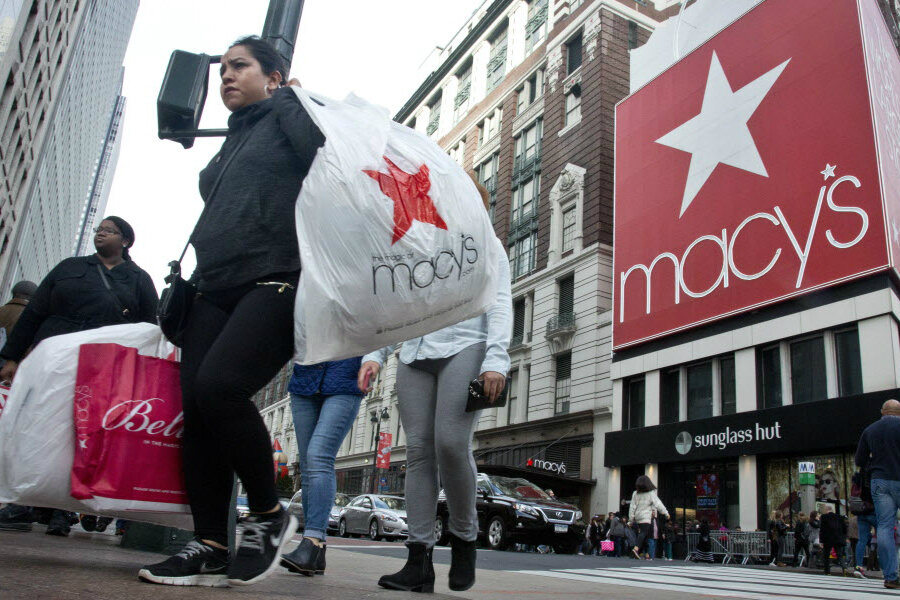Income inequality begins to reshape holiday shopping
Loading...
| Washington
American shoppers are poised to spend a bit more this year compared to last holiday season – but deeper changes in America's holiday shopping season are also at work.
In an era of wide rich-poor gaps – and a shrinking middle class – companies are changing how they think about the making and marketing of products. Aiming products at a massive and homogenous middle market no longer works so well.
Smartphones are pushing even more shoppers online.
And younger consumers are showing more interest in experiences – like travel, sports, or a memorable meal out – than in old-fashioned accumulation of stuff.
These are all gradual or incremental changes – not instant revolutions. But they’re showing up as trends this year that speak to a retail industry potentially facing a time of transition.
New trends in holiday shopping
Analysts at the investment bank Morgan Stanley see bifurcation among consumers as a long-term trend that retailers and other consumer-oriented companies are having to adapt to.
The rich-poor gap began expanding in America (and other nations) long before the Great Recession, the Morgan Stanley analysts note in a November report.
If it persists, retailers will likely continue to respond with "greater product differentiation" and "more price and quality segmentation at the top and bottom of the offering range," the analysts say. “Companies capable of embracing complexity should outperform."
In this environment, companies as diverse as McDonald’s and Macy’s are scrambling to reboot.
The complexity retailers are adapting to goes beyond income gaps. It’s also technological change and shifting tastes.
Whether the business is restaurants or department stores, many retailers see a current generation of customers that’s more interested in qualities (“hand-made,” “organic”) and in experiences like recreation and travel.
Retailers are also having to adapt to the continued migration of shopping online. Last year, online holiday retail sales represented 13.7 percent of holiday retail sales, by IHS Global Insight estimates. This year that share is likely to jump another notch higher, to 14.7 percent, predicts Chris Christopher, director of consumer research at IHS Global Insight, in a Dec. 11 analysis.
This doesn’t mean people aren’t going to the mall or buying clothes. But Macy’s stock is way down this year. (McDonald’s stock, by the way, is up amid its reinvention efforts.)
And Amazon, the king of Internet retailing, is one of the year’s hottest stocks. It has doubled its share price, and the delivery trucks are still rolling.
This season, by the numbers
By some accounts, consumers have been slow to get into the gift-shopping game this holiday season. The number of procrastinators – people who hadn’t started their shopping as of early December – was 6 percentage points higher than last year in a Consumer Reports survey at the start of the month.
But respondents in the survey were feeling notably brighter about their finances than last year. Some 28 percent of respondents said they were “fairly, very, or extremely concerned” about overspending this season, down sharply from 44 percent in 2014, Consumer Reports said. And 47 percent said they were “not at all concerned” — more than double the number that said that last year.
Those who do feel stressed about the holidays cite a money squeeze as the top concern – far above things like anxiety about travel, entertaining relatives, or not knowing what gifts to buy.
“We are forecasting holiday retail sales to rise 3.4 [percent] above last year; not as strong as last year’s growth, but a solid showing,” writes Mr. Christopher. “This holiday retail sales season is looking rather promising since consumer price inflation is modest, confidence is making a comeback … and job opportunities are looking brighter.
Falling gasoline prices are pumping extra cash into bank accounts, which some consumers are spending on extra restaurant meals as well as at the mall, says Mr. Christopher, in Lexington, Mass.
For the overall economy, this is good news. Modest gains in consumer spending have fueled steady but unexciting growth in GDP, the nation’s gross domestic product of goods and services. The economy grew at a 2 percent annualized pace in the year’s third quarter, the Commerce Department said Tuesday.
Forecasters at PNC Financial Services, in Pittsburgh, predict a 2.7 percent pace for GDP growth in the fourth quarter, and 2.4 percent for next calendar year.








